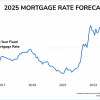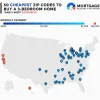When To Refinance Your Mortgage
Homeowners should decide, based on their unique situation, whether now is the right time to refinance. The best refinances save thousands of dollars, but a new loan can help in other ways, too.
Your trusted source for the latest mortgage news, trends, and advice.

Homeowners should decide, based on their unique situation, whether now is the right time to refinance. The best refinances save thousands of dollars, but a new loan can help in other ways, too.

Can a Reconsideration of Value (ROV) help increase your home's value for a mortgage?

Even brand-new homes can hide serious flaws, which is why many experts recommend a professional inspection before closing—even if the property appears perfect. While an inspection may add costs and delay your timeline, it can help uncover critical issues early, give you leverage with the builder, and provide peace of mind.

Should you get a home inspection right before your warranty expires? Some experts think so.

How are single people buying homes in this market? We take a look.

Six figures used to buy you a pretty sweet house: about 140% of the typical home. Now? About 90%. What happened?

A typical first-time buyer house payment eats up 50% of the median income. But these aren't uncharted waters. It just feels terrible because the early 2020s were comparatively so cheap.

How long will stock indices and mortgage rates, buffeted by tariff fears, continue to fall? That depends on the news.

Nearly every major agency is predicting rates in the 6s or higher for 2025. But could rates drop into the 5s? There's a solid case for that argument.

Home affordability is near all-time lows. But many areas in the U.S. are still extremely affordable. Looking to buy a home? Check these 50 ZIP codes.

New construction property taxes only include the land value. When do you have to start paying the full amount?

An expiring appraisal can put a damper on your home purchase or refinance. Here's how long they last before you need a new one.

Paying off debt at closing can help you qualify for a loan even if your current DTI is too high. You just have to commit to paying down at least enough debt to move your DTI into the approval zone.

Disputing items on your credit report can derail your mortgage approval, even if the account is inaccurate. What to do instead.

With some hard work, your credit score can skyrocket 100 points or more. Here's what it might take.